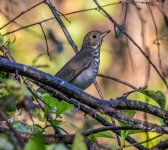I saw several thrushes today that looked like Hermits or maybe Gray-cheekeds. I didn't get a good look at the tails. In the last 2 weeks Swainson's and Veerys passed through, but I don't believe this one is either. Seen in Maryland.
As always your thoughts are warmly appreciated.
As always your thoughts are warmly appreciated.








